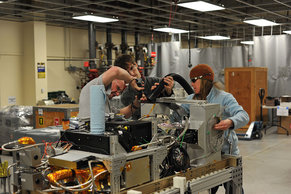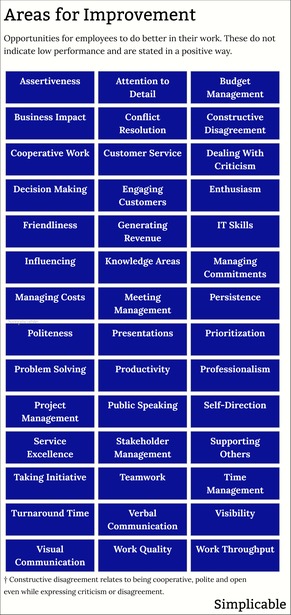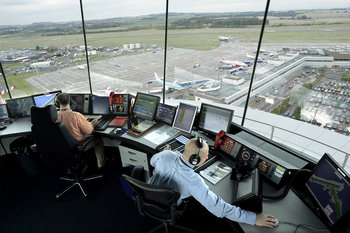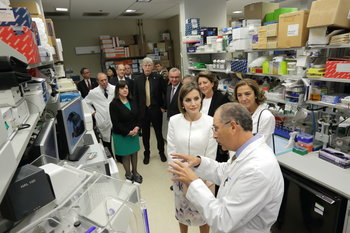
Revenue
Expectations for revenue generation may be stated generally for a role or specifically as a smart objective for performance management documentation.Aggressively grow revenue in a crowded and competitive market.
Professionalism
Professionalism is a set of basic expectations for a profession. This includes broad norms such as personal hygiene and expectations that are specific to a profession such as a code of ethics.Under all circumstances maintain professional composure in dealing with customers.
Diligence
Diligence is the care that is taken to do a task properly.Research rental applications with diligence to achieve an approval rate over 80% and a default rate below 4%.
Management
Management is the direction of teams and control of resources.Manage a team of 6-8 software developers and deliver to project commitments.
Leadership
Leadership is setting a direction that people follow. This can occur at any level of an organization and is independent of authority.Lead the design of software to produce work products of usual quality.
Buy-in
It's not always important to achieve consensus but it is often critical to get people to at least buy-in to strategies, processes, policies and decisions.Achieve business unit buy-in for application roadmap.
Customer Service
Providing diligent and friendly customer service.Demonstrate a passion for solving customer problems.
Customer Relationships
Building relationships with customers to achieve specific business goals.Build relationships with customers and support their needs to reduce annual customer attrition to 7% for your accounts.
Work Quality
Work quality is the value of a deliverable to stakeholders.Deliver software to requirements that is well structured, designed and documented. Work to clear all defects.
Ethics
Act in a way that is consistence with a firm's values.Live up to our core values.
Technical
Expectations for technical skills, abilities and work outputs.Repair elevators in a timely manner such that the first repair addresses all customer issues 95% of the time.
Best Practices
Requiring an employee to follow well established practices of a profession or domain.Adhere to project management methodologies and practices.
Standards
Requiring conformance to a specific set of standards.Conform to our information security standards and principles.
Compliance
Requiring compliance to laws, regulations and policies.Manage a team with full compliance with all applicable employment laws, regulations and internal policies.
Communication
Communication related expectations such as a role with a public speaking requirement.Represent our product by telling our story and answering questions at industry conferences and customer meetings.
Accountability
The expectation that an employee will make relevant decisions and take responsibility for both success and failure.Develop an operational strategy for cloud infrastructure platforms and answer to the success of both strategy and day-to-day operations.
Cost
Controlling and reducing cost.Reduce energy consumption by at least $1 million a month with a 5-year return on investment of at least 200% for improvements.
Productivity
Productivity is the amount of output produced in an hour, week, month or year of work.Manage the productivity of the design team to achieve average billings of $50,000 per designer per month.
Time Management
Time management is the practice of making good use of time with techniques such as mise en place or prioritization.Manage your time to meet deadlines and commitments.
Efficiency
Efficiency is the amount of output produced by an input such as machine time or electricity.Reduce the idle time of computing infrastructure by 30% by releasing unused instances and scheduling work efficiently.
Creativity
The expectation that an employee produce non-obvious value.Develop and launch a new ice cream product that achieves 13% market share within 16 months of development start.
Culture
The requirement that a employee fit into an organizational or team culture or develop a new culture.Conform to the habits, norms and expectations of the team.
Working Conditions
Specifying working conditions such as a requirement to be in the office as opposed to working from home.This role requires you to be onsite during regular business hours and during after hours maintenance and incident management activities.
Working Hours
Stating requirements and conditions related to working hours.After hours production support work is required of this role.
Locations
Expectations for travel both internationally and locally.This role requires you to regularly travel to our data centers that are up to 190 miles from headquarters.
Toolsets
The expectation that an employee use an existing toolset or develop new toolsets.Leverage our existing technology tools such as our customer relationship management system. Gain approval from the IT governance team for any new toolsets.
Process & Procedure
Adherence to existing processes and procedures or development of new ones.Setup billing accounts according to the quote-to-cash process with an median setup time of 6 business hours.
Learning
The requirement that an employee learn new things.Develop a working understanding of our platforms, infrastructure, architecture and processes within three months of start.
Personal Resilience
Personal resilience is the ability to handle stresses without losing composure or enthusiasm.Remain productive and positive in the face of intensive office politics, problems and failures.
Self Direction
The expectation that an employee find their own way to establish strategy, make decisions, clear issues and build relationships.Deliver your objectives by engaging stakeholders, securing resources and making decisions in an environment with little direction.
Analysis
Analysis is the development of new requirements, processes and other information artifacts.Engage stakeholders to identify improvements to the quote-to-cash process.
Influencing
The requirement to influence stakeholders such as management, business units or partners.Build support for strategy and achieve budget approvals.
Stakeholder Management
Managing relationships with internal and/or external stakeholders.Build a close working relationship with the equities team.
Networking
Building out and sustaining relationships.Engage developers at industry conferences to immerse yourself in the culture surrounding our products.
Services
Providing services to customers or internal customers.Provide IT services to business units to achieve SLA compliance and business unit satisfaction of at least 85%.
Decision Making
Expectations around decision making such that the requirement that decisions and their rationale be communicated clearly.Make timely decisions to clear project issues. Document the rationale for major decisions and communicate to the team.
Problem Solving
Expectations for solving problems such as a requirement to identify and address the root cause of problems.Perform a root cause analysis for major problems and address the root cause of problems in a timely manner.
Knowledge
The development, communication and use of knowledge.Perform market research and communicate insights into customer needs and competitive threats.
Reporting
The development and communication of reports that may include both data and information such as status.Deliver a dashboard that indicates the status of projects and application health.
Forecasting
Producing accurate forecasts and estimates.Produce an accurate monthly sales forecast for the sales and operations planning meeting.
Development
The creation of new value.Develop new convenient packaging for our ice cream products that improves customer perceptions of quality by 5%.
Control
The control of resources, processes and practices.Implement segregation of duties for approving, validating and auditing expenses.
Financial Management
The planning, control and administration of financial resources.Plan, control and administer a team budget.
Planning
The process of identifying and structuring the steps required to achieve a goal.Develop and execute a plan to migrate services to our new office location.
Organization
Organization is the orchestration of resources to achieve a plan.Organize and manage project meetings to review status and resolve issues.
Results
Expectations for business results.Achieve a conversion rate of at least 14%.
Summary
The following are common examples of work expectations: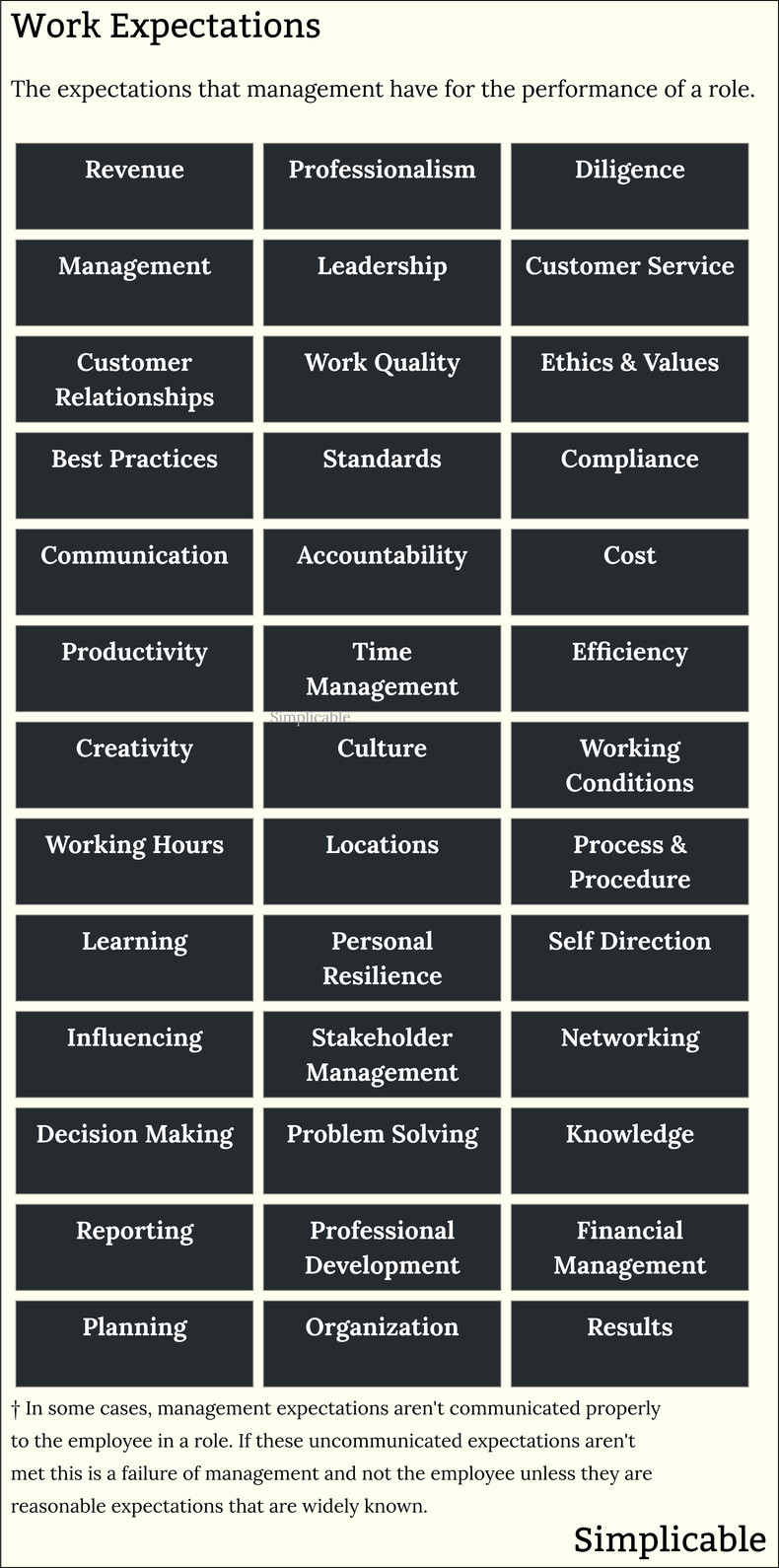
Overview
Work expectations are requirements for the performance of an employee or role. These can be formally or informally communicated. In many cases, they are also unstated assumptions that may be unfair unless they are reasonable expectations that are widely known.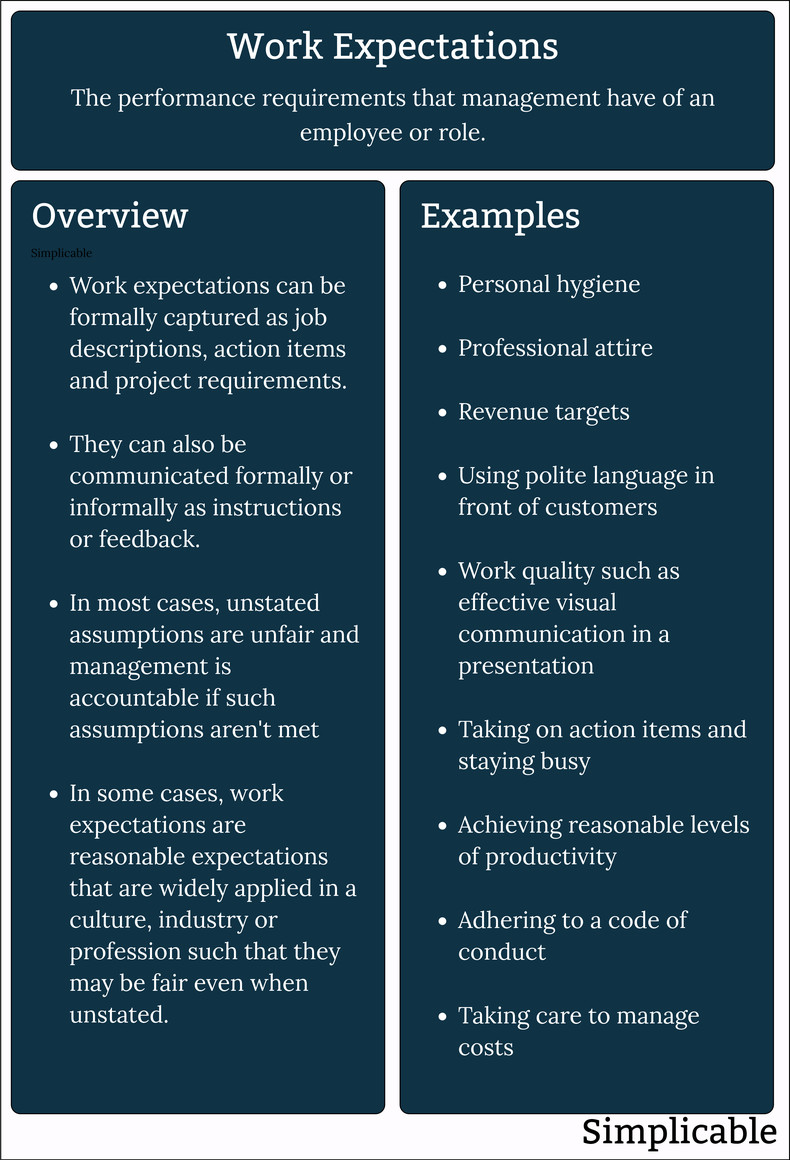
| Definition: Work Expectations | ||
Type | ||
Definition (1) | Requirements that a manager or stakeholder has of a role, responsibility, task or activity. | |
Definition (2) | Requirements for the performance of an employee or role. | |
Related Concepts | ||











